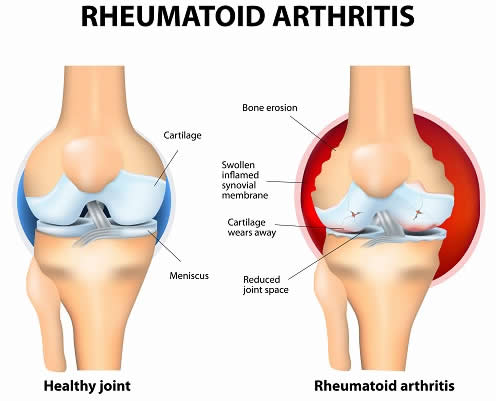Positive Health Online
Your Country

Rheumatoid Arthritis: 4 Alternative Treatments (Evidence-Based)
listed in arthritis, originally published in issue 263 - June 2020
Rheumatoid Arthritis (RA) is a chronic degenerative disease in which the body’s immune system attacks the joints. This creates inflammation which not only affects joints, but tendons, ligaments, connective tissues and skeletal muscles too. Alteration in immune and metabolic function is significantly influenced by nutrition and consequently the ability of an individual to cope with disease.

Typical symptoms of RA include pain, fatigue and general malaise. Common signs and symptom in the hands are swan neck and boutonniere deformities. Additionally, rheumatoid nodules located beneath the skin, usually in the joints of ankles, hands, or elbows, are often present and are associated with pain and stiffness which worsens in the morning or after sitting. For older people this can mean rapid loss of mobility and independence.
However, science teaches us that there are 4 powerful natural alternatives to prescription drugs, 4 in particular that can be used to effectively control, or arguably, even prevent rheumatoid arthritis (RA). This paper suggests 4 ways in which simple dietary change and supplementation could make a difference in biological function, and as a consequence, in RA.
1. Supplement with Whey Protein
Whey protein is generally good to consume in any case because it is one of the most nutritious sources of protein known to science. This is because whey protein, along with egg protein, scores highest on all protein evaluation methods [1] and contains all of the 9 essential amino acids that the human body cannot endogenously synthesise.
Whey protein also provides a significant amount of the amino acid glutamine, which can be used by the immune system to help improve immune function.[2] Glutamine from whey protein also comes just in the right form for the body to synthesise glucosamine for the joints.
Furthermore, protein powders that are derived from whey offer an additional benefit due to their high glycomacropeptide (GMP) content; a constituent protein fraction abundant in whey. Research demonstrates that GMP exhibits a number of biological regulatory functions that signal physiological activities such as immune system function.[3]
Finally, whey protein powders are probably the single best protein source for nitrogen retention and the maintenance of skeletal muscle mass. It is the skeletal muscles that provide the main source of glutamine that fires the immune system.
Dosage
Current research suggests a serving of 30 grams, taken once per day.

2. Supplement with Omega 3 Fatty Acids
Modern westerniszd diets have become more than deficient in essential fatty acids; the knock-on effect is one that has a significant detriment to people with rheumatoid arthritis. The benefits for arthritis of omega-3 fatty acids that are present in Flax seed oil were first researched by the German biochemist Dr Johanna Budwig. Since then numerous other studies have been performed, of which the results all teach us the same thing; omega 3 fatty acids are good for arthritis.[4]
Flaxseed oil is high in the essential omega-3 fatty acid alpha-linolenic acid (ALA). The body converts ALA into another omega 3 fatty acid known as eicosapentaenoic acid (EPA). It is the EPA omega 3 that has an anti-inflammatory effect.[5]
One study in particular, by Dr Joel Kramer of Albany Medical College in New York,[6] tested 3 groups of arthritis patients with either 1 of 2 different dosages of fish oil, or a particular dose of olive oil. Evaluation of the 3 groups was done by measuring various immunologic and inflammatory markers at baseline and then re-measuring every 6 weeks thereafter.
At the end of the 24 week study, the results were impressive; inflammation in the high dose fish oil group was most improved and had reduced by 54.7%.
Dosage
Current research suggests a large tablespoon of either fish oil or flaxseed oil, taken twice per day.
3. Supplement with Omega 6 Fatty Acids
Gamma linolenic acid (GLA) is the omega-6 fatty acid that is abundant in borage oil, evening primrose oil and blackcurrant oil. However at approximately 24%, 17% and 8% GLA content, accordingly, borage oil is easily the winner of the three as the preferred source of GLA.
Some omega-6 fats are pro-inflammatory; fats from sources such as some salad dressings, peanut oil, safflower /sunflower oils, and margarines. However, GLA omega 6 fats are in fact anti-inflammatory and are distinctly different in this respect.
With regard to RA, It is understood that GLA is metabolised into dihomogamma linolenic acid which is the immediate precursor of prostaglandin E1 (PGE1); an eicosanoid with anti-inflammatory and immunoregulatory properties.[7]
In fact, GLA has been shown to reduce the signs and symptoms of joint degeneration in patients with rheumatoid arthritis. One study in particular showed that sufferers of rheumatoid arthritis who took a daily dose of just 1.4 grams of GLA for six months, experienced a significant improvement in the tenderness of their joints along with a reduction in joint swelling and pain.[8]
Another 6 month study of 56 rheumatoid arthritis patients who were randomized into 2 treatment groups; placebo Vs 2.8 gm/day of GLA , also concluded that GLA is an effective treatment for RA.[9]
Dosage
Current research suggests a dose of between 1.4-2.8 grams of GLA, to be taken once per day.
4. Supplement with S-Adenosyl-Methionine (SAMe)
S-Adenosyl-Methionine (SAMe) is a naturally occurring amino acid which is endogenously synthesized from the amino acid methionine and adenosine triphosphate (ATP). As with ATP, SAMe is present in just about every cell of the human body and exhibits a vast array of biological functions. The 3 main metabolic pathways of SAMe are;
- Methylation
- Transsulfuration
- Aminopropylation
With respect to RA, SAMe works by increasing proteoglycan production in chondrocytes, which essentially maintains the soft cartilage tissues in the joints that allow for smooth and pain free movement.
Furthermore, SAMe has also been found to exhibit anti-inflammatory and analgesic effects equal to that of Ibuprofen or Naproxen, but with no observed side effects and better compliance.[10] This is probably due to SAMe’s ability to lower levels of homocysteine; a common biological marker used to measure inflammation.
The onset of orally taken SAMe is fast-acting and achieves peak plasma concentrations approximately 3 to 5 hours after ingestion of an enteric-coated tablet. The half-life of SAMe is around 100 minutes, therefore blood-plasma concentrations are better maintained by taking SAMe at regular intervals.
Dosage
Based on current research, it is suggested that a dose of 400mg should be taken at least once, if not twice per day.
Conclusion
Given the limitation of prescription drugs in treating RA, there is a strong need for natural and alternative treatments. Legitimate scientific evidence should be the corner-stone behind any purported claim that a particular food or substance, offers any sort of medicinal benefit. Based on current evidence, this paper suggests 4 efficacious alternatives to current medication.
Each of the suggested alternative treatments for rheumatoid arthritis discussed in this article, can be used individually, or, in conjunction with the others. Although I have yet to find any clinical research that examines the efficacy all of 4 treatments in combination; I believe the ‘whole’ to be greater than the sum of its parts. This is because each treatment is fundamentally different in its mechanisms and thus combining all 4 together, offers additional benefit over and above that of which any single one of the treatments may offer. Therefore I would recommend combining all 4 treatments together, and using them on a daily basis.
Finally, enjoying good health should be a priority for us all; making the right nutritional choices can significantly improve the health of both the individual, and even the nation. Not to mention, the hope that is brings to those that may be suffering from age-related disease and who are facing the ever-more apparent burden of loss of independency.
References
1. Hoffman JR and Falvo MJ Macronutrient Utilization During Exercise: Implications For Performance And Supplementation. International Society of Sports Nutrition Symposium, Las Vegas NV, USA – Symposium. 2005 June 18-19.
2. Cruzat V, Rogero MM and Keane KN Curi R Newsholme P Glutamine: Metabolism and Immune Function, Supplementation and Clinical Translation. School of Pharmacy and Biomedical Sciences, Curtin Health Innovation Research Institute, Biosciences, Curtin University, Perth 6102, Australia. 2018 Oct 23.
3. Córdova-Dávalos LE, Jiménez M and Salinas E Glycomacropeptide Bioactivity and Health: A Review Highlighting Action Mechanisms and Signaling Pathways. Department of Microbiology, Basic Science Center, Autonomous University of Aguascalientes, Aguascalientes 20131, Mexico. 2019 March 12.
4. Rajaei E, Mowla K, Ghorbani A, Bahadoram S, Bahadoram M and Dargahi-Malamir M The Effect of Omega-3 Fatty Acids in Patients With Active Rheumatoid Arthritis Receiving DMARDs Therapy: Double-Blind Randomized Controlled Trial. The Canadian Center of Science and Education (CCSE). 2015 Nov 3.
5. Calder PC Omega-3 Fatty Acids and Inflammatory Processes. Institute of Human Nutrition, School of Medicine, University of Southampton. 2010 March 18.
6. Kremer JM, Lawrence DA, Jubiz W, DiGiacomo R, and Rynes R, Bartholomew LE and Sherman M Dietary fish oil and olive oil supplementation in patients with rheumatoid arthritis Clinical and immunologic effects. Department of Medicine, Albany Medical College, NY 12208. 1990 March.
7. Reed GW, Leung K, Rossetti RG, VanBuskirk S, Sharp JT, and Zurier RB Treatment of Rheumatoid Arthritis with Marine and Botanical Oils: An 18-Month, Randomized, and Double-Blind Trial. University of Massachusetts Medical School, Department of Medicine. 2014 Mar 19.
8. Leventhal LJ, Boyce EG and Zurier RB Treatment of rheumatoid arthritis with gammalinolenic acid. University of Pennsylvania, Graduate Hospital, Presbyterian Medical Center, Philadelphia. 1993 Nov 1.
9. Zurier RB, Rossetti RG, Jacobson EW, DeMarco DM, Liu NY, Temming JE, White BM, and Laposata M gamma-Linolenic acid treatment of rheumatoid arthritis. A randomized, placebo-controlled trial. University of Massachusetts Medical Center, Worcester 01655-0335, USA. 1996 Nov.
10. Caruso I and Pietrogrande V Italian double-blind multicenter study comparing S-adenosylmethionine, naproxen, and placebo in the treatment of degenerative joint disease. Department of Rheumatology, L. Sacco Hospital, Milan, Italy. 1987 Nov 20.
Comments:
-
No Article Comments available